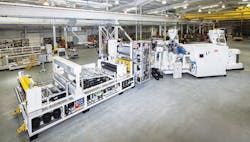Drying PET inline boosts sheet-production efficiency
PET is a hygroscopic headache. It captures moisture that has to be eliminated for the sake of a high-quality end product. That challenge has given rise to a variety of technologies designed to reduce the moisture in PET so that it can be processed effectively.
Despite the challenges, PET is a very high-volume plastic, both in production of containers, for example, and in recycling. Do you want to be rich, albeit maybe not famous? Invent a readily processible PET, or a replacement, that doesn't attract moisture.
Meanwhile, let's take a look at the nuances of technology that aims to get rid of moisture before the material is extruded into sheet. The standard approach has been to dry the PET before putting it into the extruder. Recent efforts, however, have focused on including drying/degassing steps within the extrusion setup.
The MRS Multi Rotation System from Gneuss Inc., Matthews, N.C., is a single-screw extruder with a special degassing section. The polymer melt is delivered into a large, single-screw drum that contains eight or 10 small extruder barrels parallel to the main screw axis. Installed in these small extruder barrels are the satellite screws, which rotate in the opposite direction of the main screw while they rotate around the screw axis. That increases the surface exchange of the polymer melt.
The extruder barrels that are cut into the drum of the MRS are about 30 percent open to ensure the optimum melt transfer into the barrels and so that evacuation can take place without restrictions. Precise control of the melt temperature is possible because the temperatures of all the surfaces in contact with the melt can be controlled accurately.
A patented, multiple-screw section provides a large area for degassing, even with a vacuum of only 20 to 40 millibars. Therefore, the extrusion of undried PET bottle flakes or pellets with moisture content up to 12,000 parts per million (ppm) is possible.
The MRS system creates a melt surface exchange rate 25 times greater than with a co-rotating twin-screw extruder, according to the company. Further benefits are the 100 percent dehumidification of PET as well as the possibility of increasing the intrinsic viscosity. The rotating satellite screws run in individual bearings and are therefore comparable with a drum containing a number of single screws.
A South American user of Gneuss equipment manufactures sheet for thermoforming from 100 percent post-consumer bottle flakes. These are processed without any pre-drying even though the flakes can have a moisture level of up to 10,000 ppm.
Another South American processor, SIK Plastic, São Paulo, this summer started using an MRS 110 extruder with a throughput of about 1,280 pounds per hour. The company, which processes post-consumer material, is manufacturing PET sheet for packaging.
For PET sheet production using post-consumer bottle flake, the devolatilizing effect of the MRS extruder is not only useful for removing moisture: It is also useful for decontaminating the melt so that the process is acceptable to the U.S. Food and Drug Administration.
In another example, an unnamed U.S. manufacturer of sheet for thermoforming and thermoformed containers has successfully dispensed with the expensive and energy-intensive processing step of crystallizing and drying the PET prior to extrusion. This company operates an extrusion line with a throughput of 2,205 pounds per hour. Most of the sheet is made into containers for fruit.
The MRS extruder plasticates and devolatizes the material, the Gneuss RSFgenius filters the material and the online viscometer measures the viscosity immediately upstream of the die and controls the vacuum pump at the devolatilizing section of the extruder in order to maintain the viscosity within a narrow range. In this way, the quality and thickness of the sheet can be maintained.
Welex, York, Pa., part of Graham Engineering Corp., supplies the V-PET sheet line, which is used by Arnon Plastic Industries Co. Ltd., Dammam, Saudi Arabia. The company produces PET and PS food trays and containers, as well as PE rolls and sheets for the construction industry.
The latest line features tandem 130mm screw extruders that include high-vacuum moisture- evacuation pumps. This enables high-quality PET sheet production without recrystallizing or pre-drying. Tandem, fully automatic transfer turret winders allow automatic roll removal. The control system provides for remote access.
Processing Technologies International LLC (PTi), Aurora, Ill., has a strategic alliance with Italian equipment-maker Costruzioni Meccaniche Luigi Bandera, Busto Arsizio, Italy, to offer dryer-less PET sheet extrusion systems. The patented Bandera high-vacuum, twin-screw extrusion (HVTSE) technology employs a single atmospheric vent and a dual high-vacuum vent system with a co-rotating twin-screw extruder. This approach allows moisture and volatiles to be removed as part of the extrusion process. In the case of recycled PET, the need for recrystallization of the material is also eliminated. The energy savings from elimination of these drying and crystallization steps can be 30-35 percent over the conventional method. The PTi/Bandera HVTSE technology is available exclusively from PTi in North America.
Battenfeld-Cincinnati USA, McPherson, Kan., offers a single-screw extruder system with planetary roll degassing for PET processing. Three extruder sizes are available for PET sheet extrusion without predrying. The first single-screw zone produces a homogenous melt that is then degassed under a high vacuum in the planetary roller section. The planetary section is followed by a short, single screw for pressure buildup, which conveys the degassed polymer to the melt pump and the die.
Merle R. Snyder, senior correspondent
Contact:
Battenfeld-Cincinnati USA, 620-241-6843, www.battenfeld-cincinnati.comGneuss Inc., 704-841-7251, www.gneuss.comProcessing Technologies International LLC, 630-585-5800, www.ptiextruders.comWelex, 215-542-8000, www.welex.com


